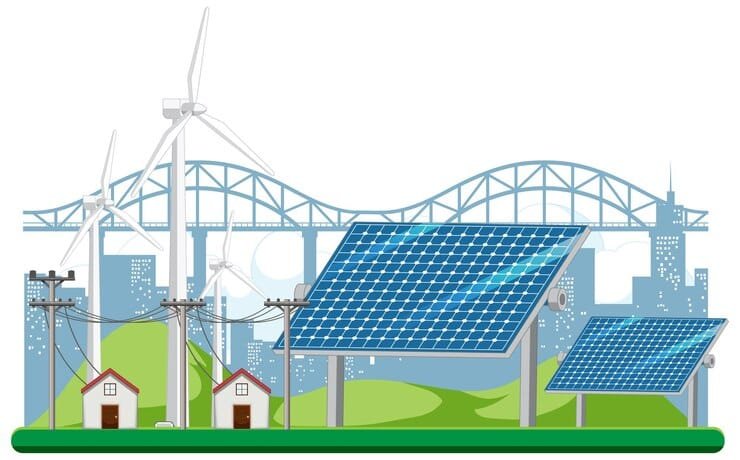Power Struggle: How Electricity Generation is Reshaping the Energy Landscape
The global energy landscape is a battlefield, and the war is for dominance in electricity generation. Fossil fuels, the entrenched incumbents, cling to their power, fueled by decades of infrastructure and ingrained practices. Yet, a potent insurgency—comprising solar, wind, hydro, and burgeoning nuclear advancements—is challenging this hegemony with disruptive technologies and unwavering momentum. This isn’t merely a shift in fuel sources; it’s a tectonic restructuring of entire energy systems, demanding a radical reassessment of our approaches to grid management, resource allocation, and long-term sustainability.
The stakes are impossibly high. The International Energy Agency projects a 50% increase in global electricity demand by 2050, a demand that simply cannot be met without a fundamental transformation in our generation methods. The climate crisis, driven largely by carbon emissions from traditional power plants, presents an existential threat, demanding a swift and decisive shift towards cleaner alternatives. To ignore this reality is to gamble with the future of our planet, a gamble no responsible business leader or energy professional can afford.
Some argue that the transition will be too costly, too disruptive, too slow. They point to the complexities of integrating intermittent renewable sources and the perceived unreliability of certain technologies. However, these arguments are increasingly refuted by demonstrable advancements in battery storage, smart grid technologies, and the plummeting cost of renewable energy itself. The true cost of inaction—environmental degradation, energy insecurity, and the economic repercussions of climate change—far outweighs the perceived challenges of this necessary transition.
This blog post will dissect the ongoing power struggle in electricity generation, analyzing the strengths and weaknesses of competing technologies, examining the policy landscapes shaping this evolution, and ultimately, offering a strategic roadmap for navigating this crucial period of transformation. Prepare for a critical examination of the energy future, a future where decisive action, not complacency, will determine the victor.
The electricity generation market is undergoing a seismic shift, driven by a perfect storm of technological advancements, evolving regulatory landscapes, and escalating climate concerns. This isn’t mere evolution; it’s a revolution demanding immediate strategic adaptation. Failure to grasp the nuances of these trends will condemn companies to obsolescence.

Positive Trends:
- The Rise of Renewables: The inexorable march of renewable energy sources – solar, wind, hydro – is undeniable. Technological advancements have slashed costs, making them increasingly competitive with fossil fuels. Companies like Ørsted, once a fossil fuel giant, have successfully pivoted, becoming global leaders in offshore wind, demonstrating the viability of a complete transformation. This trend presents a colossal opportunity for companies willing to embrace innovation and invest in renewable energy infrastructure. Actionable Insight: Aggressively invest in R&D for next-generation renewables (e.g., advanced solar, wave energy), develop robust energy storage solutions, and forge strategic partnerships to access capital and expertise.
- Decentralization and Distributed Generation: The traditional centralized power generation model is crumbling. Microgrids, rooftop solar, and community-owned renewables are empowering consumers and reducing reliance on large-scale power plants. This trend creates opportunities for smaller, agile companies to carve out niches and offer customized energy solutions. Actionable Insight: Focus on developing modular and scalable energy solutions adaptable to distributed generation models. Invest in smart grid technologies to manage distributed energy resources effectively.
- Digitalization and AI: Data analytics, artificial intelligence, and the Internet of Things (IoT) are revolutionizing grid management, optimizing energy production, and enhancing predictive maintenance. Companies harnessing these technologies gain a significant competitive edge. Actionable Insight: Invest heavily in data analytics capabilities to improve efficiency, predict demand, and optimize operations. Develop AI-driven solutions for predictive maintenance and grid management.
Adverse Trends:
- Intermittency of Renewables: The inherent variability of solar and wind power poses a significant challenge. Without robust energy storage solutions and effective grid management, intermittent renewable sources can compromise grid stability. Actionable Insight: Prioritize investments in energy storage technologies (batteries, pumped hydro, etc.) and actively participate in grid modernization initiatives. Develop sophisticated forecasting models to better predict and manage intermittent power supply.
- Regulatory Uncertainty: The regulatory landscape surrounding electricity generation is volatile. Changes in environmental regulations, carbon pricing mechanisms, and subsidy policies can significantly impact profitability and investment decisions. Actionable Insight: Engage proactively with policymakers to advocate for supportive policies and maintain a flexible business model adaptable to evolving regulatory frameworks. Conduct thorough regulatory risk assessments and develop contingency plans.
- Geopolitical Instability: Global events, such as conflicts and supply chain disruptions, can dramatically impact the availability and price of crucial materials used in energy production and infrastructure development. Actionable Insight: Diversify sourcing of materials and develop robust supply chain resilience strategies. Invest in local manufacturing where feasible.
Ignoring these trends is not an option. The electricity generation market is transforming at an unprecedented pace, creating both enormous opportunities and significant risks. Companies that proactively embrace innovation, adapt to changing regulations, and mitigate potential disruptions will be the ones to thrive in this electrifying future. Those that fail to adapt will be left behind, a stark warning to those clinging to outdated business models.
Healthcare: Hospitals are voracious electricity consumers. Reliable, uninterrupted power is not merely a convenience; it’s a life-or-death necessity. Investing in on-site renewable generation, like solar arrays or combined heat and power (CHP) systems, drastically reduces reliance on the grid, mitigating the risk of outages and associated costs—lives, and financial losses—during emergencies. The financial case is compelling; reduced reliance on the grid means lower energy bills and potentially higher insurance premiums due to reduced risk. This isn’t just about cost-cutting; it’s about bolstering operational resilience, attracting patients, and enhancing their brand. Ignoring this opportunity is simply negligent.
Technology: Data centers, the backbone of the digital economy, guzzle electricity. Companies like Google and Microsoft are aggressively pursuing renewable energy sources to power their massive infrastructure. This isn’t just altruism; it’s shrewd business. Consumers are increasingly demanding environmentally responsible practices, and sustainable operations enhance a company’s brand reputation. Furthermore, procuring renewable energy can often be cheaper in the long run than relying solely on the grid, especially given the volatility of fossil fuel prices. Conversely, failing to address energy consumption leaves companies vulnerable to escalating energy costs, reputational damage, and regulatory pressure.
Automotives: Electric vehicle (EV) production necessitates massive amounts of electricity. Automakers are partnering with utilities to ensure a stable and sustainable energy supply for manufacturing facilities. This collaboration ensures production isn’t hampered by power shortages and provides a crucial advantage in a competitive landscape. Furthermore, initiatives like on-site solar generation showcase a commitment to sustainability, attracting environmentally conscious consumers and investors. Ignoring this trend means falling behind competitors who are actively pursuing renewable energy solutions—a strategic blunder.
Manufacturing: Heavy industries are increasingly adopting on-site generation using CHP technologies, capturing waste heat to generate electricity and enhance overall efficiency. This reduces operational costs and minimizes carbon footprint, aligning with growing regulatory pressures for sustainability. For example, steel mills utilizing waste gas from their processes for power generation can achieve significant cost savings while decreasing their environmental impact. Failing to explore and implement such strategies translates to lost opportunities for cost reduction and increased competitiveness in a market demanding environmental responsibility.
Counterargument: Some may argue that initial investments in renewable generation are substantial. However, the long-term cost savings, enhanced resilience, and improved brand image significantly outweigh the upfront capital expenditures. The strategic advantage gained from operational stability and environmental leadership far surpasses the short-term financial constraints. Ignoring this reality invites market disruption and lost profitability.
Thesis Statement: Electricity generation companies are increasingly pursuing a dual strategy of aggressively expanding renewable energy sources organically while simultaneously leveraging inorganic growth through mergers, acquisitions, and strategic partnerships to achieve rapid decarbonization and market dominance.
Organic Growth Strategies:
- Accelerated Renewable Energy Deployment: Since 2023, many companies have significantly increased their investments in solar and wind energy projects. For example, NextEra Energy has announced ambitious expansion plans for its renewable energy portfolio, aiming to add gigawatts of capacity annually. This demonstrates a commitment to organic growth through direct investment in core renewable assets, driving both capacity expansion and revenue generation. A counterargument might be the intermittency of renewables; however, advancements in energy storage technologies and grid management are mitigating this risk.
- Digitalization and Grid Modernization: Companies are investing heavily in smart grid technologies and data analytics to improve grid efficiency and integrate renewables more effectively. This includes using AI for predictive maintenance of existing infrastructure and optimizing energy distribution. While the upfront cost of such modernization is significant, the long-term benefits of reduced operational costs and increased grid stability justify the investment.
Inorganic Growth Strategies:
- Strategic Acquisitions: Several companies have engaged in acquisitions of smaller renewable energy developers or companies with specialized technologies. This allows for rapid scaling of capacity and access to innovative solutions, avoiding the lengthy process of building new projects from the ground up. For instance, a major utility might acquire a smaller company specializing in offshore wind technology to rapidly expand its capabilities in this area. The counterargument is the potential for integration challenges and inflated acquisition costs; however, careful due diligence can minimize these risks.
- Joint Ventures and Partnerships: Companies are forming partnerships to share resources and expertise in developing large-scale renewable energy projects. This approach reduces risk and allows companies to leverage each other’s strengths, especially in navigating complex regulatory environments and securing financing for large projects. A partnership between a utility and a technology provider, for example, might accelerate the deployment of advanced energy storage solutions. While sharing profits can dilute returns, the benefits of reduced risk and faster deployment often outweigh these concerns.
- International Expansion: Companies are exploring opportunities in emerging markets with strong renewable energy potential. This broadens their market reach, mitigates risks associated with relying solely on domestic markets, and contributes to global decarbonization efforts. However, navigating different regulatory frameworks and geopolitical uncertainties presents challenges to this strategy.

Outlook & Summary: A Gridlock on the Horizon?
The energy landscape is not merely shifting; it’s undergoing a tectonic upheaval. This blog post has dissected the power struggle currently defining electricity generation, showcasing the brutal competition between entrenched fossil fuel interests and the surging tide of renewables. The next 5-10 years will be a crucible, forging a new energy order. We’ve argued that the narrative of a smooth transition to renewables is dangerously simplistic; instead, expect a period of intense volatility, characterized by grid instability, regulatory battles, and potentially, even energy shortages in certain regions. This isn’t just about electricity generation; it’s a systemic crisis impacting the entire electric utilities sector.
The key takeaway is stark: business-as-usual is suicidal. While proponents of fossil fuels cling to the perceived reliability and predictability of their incumbency, the economic and environmental realities are inexorably turning against them. The intermittent nature of renewables presents a genuine challenge, but dismissing their exponential growth is akin to ignoring the elephant in the power plant. The solution isn’t a simplistic “either/or” but a strategic, sophisticated blend of diverse generation sources, underpinned by massive grid modernization and innovative storage solutions. Those utilities that fail to adapt—those clinging to outdated business models and resisting change—risk becoming obsolete, relics of a bygone era. Conversely, those who embrace the disruption, strategically investing in diversified portfolios and next-generation technologies, will not only survive but thrive in this new, electrified world.
Counterarguments often cite the unreliability of renewables and their higher upfront costs. However, these arguments fail to account for the plummeting costs of solar and wind, the accelerating development of battery storage, and the long-term economic and environmental costs of fossil fuel dependence, including the escalating externalities of climate change.
The future of electricity generation isn’t pre-ordained; it’s a battleground. Are you prepared to fight for your stake in it?


